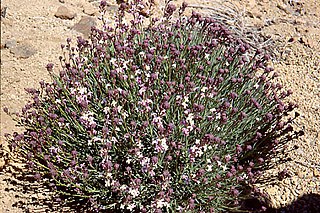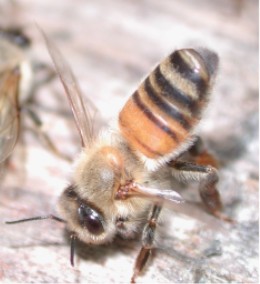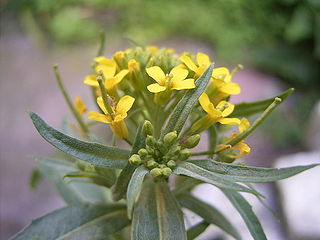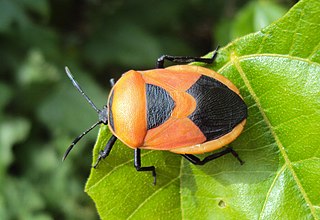
Erysimum, or wallflower, is a genus of flowering plants in the cabbage family, Brassicaceae. It includes more than 150 species, both popular garden plants and many wild forms. The genus Cheiranthus is sometimes included here in whole or in part. Erysimum has since the early 21st century been ascribed to a monogeneric cruciferous tribe, Erysimeae, characterised by sessile, stellate (star-shaped) and/or malpighiaceous (two-sided) trichomes, yellow to orange flowers and multiseeded siliques.

A pheromone is a secreted or excreted chemical factor that triggers a social response in members of the same species. Pheromones are chemicals capable of acting like hormones outside the body of the secreting individual, to affect the behavior of the receiving individuals. There are alarm pheromones, food trail pheromones, sex pheromones, and many others that affect behavior or physiology. Pheromones are used by many organisms, from basic unicellular prokaryotes to complex multicellular eukaryotes. Their use among insects has been particularly well documented. In addition, some vertebrates, plants and ciliates communicate by using pheromones. The ecological functions and evolution of pheromones are a major topic of research in the field of chemical ecology.
Chemical ecology is the study of chemically-mediated interactions between living organisms, and the effects of those interactions on the demography, behavior and ultimately evolution of the organisms involved. It is thus a vast and highly interdisciplinary field. Chemical ecologists seek to identify the specific molecules that function as signals mediating community or ecosystem processes and to understand the evolution of these signals. The substances that serve in such roles are typically small, readily-diffusible organic molecules, but can also include larger molecules and small peptides.

A bark beetle is the common name for the subfamily of beetles Scolytinae. Previously, this was considered a distinct family (Scolytidae), but is now understood to be a specialized clade of the "true weevil" family (Curculionidae). Although the term "bark beetle" refers to the fact that many species feed in the inner bark (phloem) layer of trees, the subfamily also has many species with other lifestyles, including some that bore into wood, feed in fruit and seeds, or tunnel into herbaceous plants. Well-known species are members of the type genus Scolytus, namely the European elm bark beetle S. multistriatus and the large elm bark beetle S. scolytus, which like the American elm bark beetle Hylurgopinus rufipes, transmit Dutch elm disease fungi (Ophiostoma). The mountain pine beetle Dendroctonus ponderosae, southern pine beetle Dendroctonus frontalis, and their near relatives are major pests of conifer forests in North America. A similarly aggressive species in Europe is the spruce ips Ips typographus. A tiny bark beetle, the coffee berry borer, Hypothenemus hampei is a major pest on coffee plantations around the world.
The anal glands or anal sacs are small glands near the anus in many mammals, including dogs and cats. They are paired sacs on either side of the anus between the external and internal sphincter muscles. Sebaceous glands within the lining secrete a liquid that is used for identification of members within a species. These sacs are found in many species of carnivorans, including wolves, bears, sea otters and kinkajous.

The cereal leaf beetle is a significant crop pest, described by Carl Linnaeus in 1758.

An allomone is a type of semiochemical produced and released by an individual of one species that affects the behaviour of a member of another species to the benefit of the originator but not the receiver. Production of allomones is a common form of defense against predators, particularly by plant species against insect herbivores. In addition to defense, allomones are also used by organisms to obtain their prey or to hinder any surrounding competitors.

Erysimum cheiranthoides, the treacle-mustard,wormseed wallflower, or wormseed mustard is a species of Erysimum native to most of central and northern Europe and northern and central Asia. Like other Erysimum species, E. cheiranthoides accumulates two major classes of defensive chemicals, glucosinolates and cardiac glycosides.

Mikania micrantha is a tropical plant in the family Asteraceae; known as bitter vine, climbing hemp vine, or American rope. It is also sometimes called mile-a-minute vine. It is known as Japani lota in Assam.
Margaric acid, or heptadecanoic acid, is a crystalline saturated fatty acid. Its molecular formula is CH3(CH2)15CO2H. Classified as an odd-chain fatty acid, it occurs as a trace component of the fat and milkfat of ruminants, but it does not occur in any natural animal or vegetable fat at high concentrations. For example, it comprises only 2.2% of the fats from the fruit of the durian species Durio graveolens. However, in the 19th and early 20th centuries, there were numerous reports of the acid being found in natural fats in significant amounts. Most likely, these were cases of misidentifying a eutectic mixture of palmitic and stearic acids. Salts and esters of margaric acid are called heptadecanoates.

Helicoverpa assulta, the oriental tobacco budworm, is a moth of the family Noctuidae. H. assulta adults are migratory and are found all over the Old World Tropics including Asia, Africa, and Australia.
Green leaf volatiles (GLV) are volatile organic compounds that are released when plants suffer tissue damage. Specifically, they include aldehydes, esters, and alcohols of 6-carbon compounds released after wounding. These compounds are very quickly produced and emitted, and are used by nearly every green plant. Plants constantly release GLVs, but un-stressed plants release them in much smaller amounts. Some of these chemicals act as signaling compounds between either plants of the same species, of other species, or even vastly different lifeforms like insects. Some, although not necessarily all, of these chemicals act essentially as plant pheromones.[12] GLVs also have antimicrobial properties to prevent infection at the site of injury.

The European spruce bark beetle, is a species of beetle in the weevil subfamily Scolytinae, the bark beetles, and is found from Europe to Asia Minor and some parts of Africa.

The juniper shield bug, , is a large (9–10.5 mm) green shield bug with distinctive pinkish-red markings on the corium.

(S)-Ipsdienol is a terpene alcohol. It is one of the major aggregation pheromones of the bark beetle. It was first identified from Ips confusus, in which it is believed to be a principle sex attractant. It is suggested that the compound plays a role in interspecies communication between Ips latidens and Ips ini, facilitating reductions in competition for breeding material and/or mating interference.

Ips is a genus of beetles in the family Curculionidae, the true weevils. They are bark beetles, members of the subfamily Scolytinae. Species are distributed throughout the Northern Hemisphere. Some are known as introduced species in Australia and Africa. Many species are pests of forest trees, especially pines and spruces. They are known commonly as engraver beetles, ips engraver beetles, and pine engravers.

Dryobius sexnotatus is a species of beetle in the family Cerambycidae. It is the only species in the monospecific genus Dryobius.
This is a glossary of terms used in the descriptions of ants.

Coridius janus, sometimes known as the red pumpkin bug, is a species of bug in the family Dinidoridae. It feeds by sucking on the sap on soft parts of plants especially in the cucurbit family and causes damage to crops.

Mastophora hutchinsoni, also known as the American bolas spider, is a species of orb weaver in the genus Mastophora. The genus is distributed extensively throughout various subtropical geographical areas including Australia, South Africa, Oriental Asia, and the Americas and is not found in Europe. The hunting behavior of adult female M. hutchinsoni is unusual because they are bolas spiders. They mimic moth pheromones to attract male moths, and female M. hutchinsoni have evolved to alter their chemical release to target different moths. They then capture their prey with a sticky drop on the end of a silk line, resembling a bolas.













